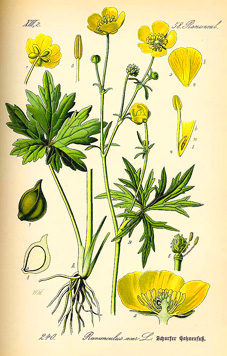Blistering Buttercup
By Audrey Stallsmith

When daisies pied, and violets blue,
And lady smocks all silver white.
And cuckow-buds of yellow hue
Do paint the meadows with delight. . .
Shakespeare--Love’s Labours Lost
The cuckow-buds mentioned in the quote above are believed to be buttercups, though the species isn’t specified! I’m guessing that the ones which infest my garden here in Pennsylvania, flowering in late spring, are the meadow type (Ranunculus acris).
Acris sends out runners, after all, and mine definitely do that. In fact, they probably should be called Runculus, since they have run right over to my garden from the pasture and there run over any other plants which happen to be in their way.
I have to admit that the shiny yellow flowers--which stand for “childishness” in the Language of Flowers--are pretty, and many a tot has "buttered up" his mother with a ragged bouquet of them accompanied by daisies. Youngsters still like to play the buttercup-under-the chin game, too, which was set to rhyme in an 1880 volume titled The Child’s Own Book of Poetry.
Bright little buttercup, now you will show
Whether my darling likes butter or no.
Buttercup, buttercup, will you begin?
Show me an answer under her chin.
Actually, the flower will cause a buttery glow on anybody’s chin because it is especially designed to reflect so much light that it will be highly visible to pollinators. Wordsworth once described the look-at-me blooms as, ““Buttercups that will be seen, Whether we will see or no.”
Ranunculus derives from “little frog,” since the foliage is believed to resemble either a frog’s or “crow’s foot.” The adjective in this article’s title refers not only to the speed with which acris (translated as “sharp” or “irritating”) can spread, but to the fact that its toxic juice can blister the hand that pulls it or livestock mouths that eat it. (I’ve actually never noticed any irritation from the many buttercups that I have grubbed up, but I usually wear gloves for weeding.)
In fact, beggars once used the plant’s roots to cause sores on their skins, which allowed them to look especially pitiful. Back “in the day” blisters on the skin often were used to treat health issues such as gout and rheumatism too. And buttercup sap also apparently was irritating enough to remove warts.
A tincture of the plant once was used to cure shingles too. And more recent experiments have discovered that its antimicrobial action even is effective against MRSA. Although the toxins in buttercup foliage are believed to be destroyed when that foliage either is dried or boiled, I haven’t seen any guarantees about that. So I’ll just stick to admiring the glowing “cups” in the pasture and rooting out the ones in my garden!
The Ranunculus acris image is by O. W. Thomé from Flora von Deutschland Österreich und der Schweiz, courtesy of plantillustrations.org.








